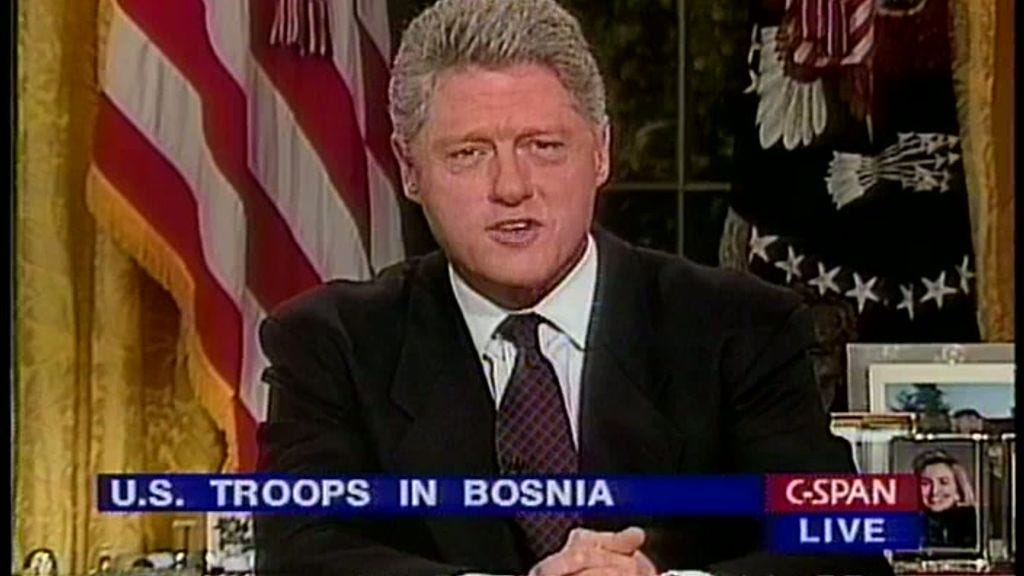March 1993.
While the new U.S. President, Bill Clinton, and the Russian President, Boris El’cin, endorse the Vance-Owen Plan with difficulty, the Serb counteroffensive proceeds in Bosnia and Herzegovina [you can listen to the latest episode of BarBalkans - Podcast here].
Serbs and Bosnian Serbs siege Bosnian towns and cities in the Drina Valley one after another, wiping dozens of Bosniak villages off the map and continuing ethnic cleansing operations.
The U.N. Protection Force (UNPROFOR) is struggling day by day, while international diplomacy is looking for solutions to put an end to the military crisis that has been blooding Bosnia for almost a year.
The tragedy of Cerska and Srebrenica
The town of Cerska falls immediately, in early March. After setting fire to more than 20 surrounding villages, the Republika Srpska Army led by Ratko Mladić besieges and conquers in a few days the town on the Drina River.
To respond to the news reporting massacres - such as the 700 besieged citizens ambushed while trying to escape - the controversial French UNPROFOR commander, General Philippe Morillon, announces a theatrical decision.
On March 5, he will visit Cerska, to discover himself what is happening.
But once back, General Morillon announces to the press that «there has been no massacre». And how can he be so sure about it, reporters ask. «There was no smell of death».
The well-known French appeasement policy continues to play into the hands of the strongest warring party, Serbs and Bosnian Serbs, as they can continue their offensive against the last Muslim-majority towns along the Drina River.
With the fall of Konjević Polje, the entire left bank of the river is under the control of Mladić’ army, except for three Bosnian strongholds: Žepa, Goražde and Srebrenica.

Thousands of refugees are arriving in Srebrenica, but the city is already in a critical situation. There is a lack of first aid medicines, water, electricity.
A week after the controversy on the alleged massacre in Cerska, the UNPROFOR commander decides to go on a mission to Srebrenica, escorted by Blue Helmets and accompanied by international medical practioners.
However, the events are out of Morillon’s control, and he has to make the best of a bad situation.
The women of Srebrenica prevent his armored car to leave, in an attempt to keep him in Srebrenica. The UNPROFOR commander is considered a lifesaver to avoid the worst, as Bosnian Serbs are advancing.
«I am your defense shield and will stay here until the convoy arrives» for humanitarian aid and evacuation of the wounded and vulnerable citizens, Morillon promises.
After two days of negotiations with Mladić, the French general leaves Srebrenica, on March 13, when he is sure that three UNHCR (United Nations High Commissioner for Refugees) convoys will arrive by the end of the month.
Nevertheless, a violent controversy breaks out between the UNHCR and the authorities in Sarajevo. Bosnian Serb besiegers block humanitarian aid, but they do not create problems for the empty buses needed to get people out of Srebrenica.
This is why for the Bosnian government, UNHCR-led evacuations facilitate ethnic cleansing and deportations in a Muslim-majority town on the border with Serbia.
Political positions on the new map of Bosnia
The war in Bosnia has been continuing for months on two levels. The real war, fought in villages and in the capital Sarajevo. And the international diplomacy, looking for a final solution to put an end to the conflict.
The peace plan signed by the European Community negotiator for the former Yugoslavia, David Owen, and the UN Special Envoy to Bosnia, Cyrus Vance, seems to be gaining momentum after initial resistance.
On March 25, President of Bosnia, Alija Izetbegović, is forced to sign the agreement due to the increasingly critical situation in the country. And despite the betrayal of Western promises about maintaining a united, sovereign and democratic country.
He signs the peace plan in blood, his fellow citizens’ blood. «We could not save our State, but we have saved our people», he tersely comments in New York.
With the risk of being crushed by a Croat entity backed by Zagreb and a Serb entity supported by Belgrade, authorities in Sarajevo try to reinforce what remains of their State, in order to prevent the disappearance of Bosnian Muslims.
For example, ethnic Croats and Serbs are disappearing from the high ranks of the Army of the Republic of Bosnia and Herzegovina.

While the map of the future Bosnia and Herzegovina is also accepted by the President of the Croatian Republic of Herzeg-Bosnia, Mate Boban, the situation is much more delicate for Serbs of Bosnia.
The President of Republika Srpska, Radovan Karadžić, opposes the Vance-Owen Plan and tries to buy time.
U.S. threats to lift the arms embargo on the entire territory of the former Yugoslavia lack credibility, because of Clinton administration’s diplomatic turnarounds.
The main points of the Vance-Owen Plan have been accepted in Washington, but with no intention of supporting it with a UN resolution. The reason is always the same: the U.S. President does not want to risk sending soldiers to the Balkans.
As a consequence, Serbs are now certain that there is no need to fear U.S. bombing.
Operation Deny Flight
Speaking of bombing, a new decision taken on March 31 in New York has direct consequences in the skies over Bosnia.
The U.N. Security Council approves Resolution 816, that authorizes the use of «all necessary measures» to make the ban on military flights in Bosnian airspace effective.
In just six months, more than 500 violations have been committed almost exclusively by Serbian aircraft to transport weapons and soldiers to the Bosnian Serb army.
Operation Deny Flight is a purely political demonstration of military power by the international community, in support of the diplomatic action of the Vance-Owen Plan.
For the very first time in history, the North Atlantic Treaty Organization (NATO) is allowed to implement military operation outside the territory of its Member Countries.
In order to prevent indefensible positions for the Russian President El’cin, the 16 allies decide to limit the action of NATO air forces, following a request from Moscow.
North Atlantic Alliance aircraft can neither fire on ground targets (even if attacked) nor chase aircraft into Federal Republic of Yugoslavia airspace.
This is a no-fly zone, but with major obstacles for its implementation already at the time of inception.
If you know someone who can be interested in this newsletter, why not give them a gift subscription?
Here is the archive of BarBalkans - Podcast:
And here you can find a summary of the past years:

















Share this post